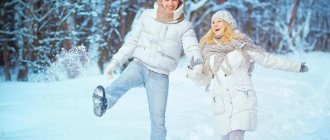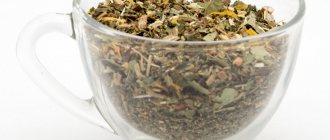The benefits of winter jogging
The benefits of running are undeniable, and in winter there are several more advantages:
- Physical activity in the fresh air has benefits for the respiratory system. And due to the fact that winter air is richer in oxygen than summer air, it is much easier to breathe while jogging.
- In winter, the ankle joints, as well as the muscles of the thighs and buttocks, are strengthened much more effectively. The body spends more energy moving on slippery roads or snow drifts. In addition, the immune system is strengthened, mood improves, endurance and willpower are developed.
- In such conditions, the heart and lungs develop well. The body will gradually begin to harden and in the future low temperatures will not make it shiver from the cold.
- Jogging provides a large supply of oxygen, and even more so in winter, so winter jogging helps you lose weight faster.
Training program
The lesson plan should be drawn up based on the achievement of which effect is a priority. If the main goal is to get rid of extra pounds, training should be frequent and long-lasting, accompanied by other types of aerobic exercise.
Table: approximate running program for weight loss for a week
| Day of the week | Morning | Evening |
| Monday | Running outside | Jumping rope at home - 20-30 minutes |
| Wednesday | Running outdoors | Abdominal exercises (crunches, leg raises from a lying position) - 3-4 sets of 15-20 repetitions |
| Friday | Run | Work on an exercise bike - 25-35 minutes |
On days off from training, it is recommended not to reduce physical activity, but to engage in sports games, swimming, and spend a lot of time on long walks.
To keep the body in good shape, along with jogging, the training complex should include strength exercises for large muscle groups: back, chest, abdominals.
Table: weekly training complex for tone
| Day of the week | Exercises |
| Monday | Running outdoors |
| Tuesday | Push-ups - 3 sets of 15-20 repetitions (girls are recommended to do push-ups from their knees or from a bench) |
| Wednesday | Day off |
| Thursday | Pull-ups on the horizontal bar - 3 sets of 8-10 repetitions (girls are allowed to do pull-ups on a low bar) |
| Friday | Running outside |
| Saturday | Abdominal exercises - 4-5 sets of 12-15 reps |
| Sunday | Day off |
Table: Example of an 8-week running program for beginners
| A week | Monday | Tuesday | Wednesday | Thursday | Friday | Saturday | Sunday |
| 1 | Cycle 10 times: run 1 minute; walk 2 minutes | Rest | Cycle 10 times: run 1 minute; walk 2 minutes | Rest | Cycle 10 times: run 1 minute; walk 2 minutes | Cycle 10 times: run 1 minute; walk 2 minutes | Rest |
| 2 | Cycle 10 times: run 2 minutes; walk 1 minute | Rest | Cycle 7 times: running 3 minutes; walking 1 minute | Rest | Cycle 6 times: running 4 minutes; walking 1 minute | Cycle 6 times: running 4 minutes; walking 1 minute | Rest |
| 3 | Cycle 5 times: run 5 minutes; walk 1 minute | Rest | Cycle 5 times: run 5 minutes; walk 1 minute | Rest | Cycle 4 times: run 6 minutes; walk 1 minute | Cycle 4 times: run 6 minutes; walk 1 minute | Rest |
| 4 | Cycle 3 times: run 8 minutes; walk 1 minute | Rest | Cycle 3 times: run 9 minutes; walk 1 minute | Rest | Cycle 2 times: run 10 minutes; walk 1 minute; after the cycle run 8 minutes | Cycle 2 times: run 10 minutes; walk 1 minute; after the cycle run 8 minutes | Rest |
| 5 | Cycle 2 times: run 11 minutes; walk 1 minute; after the cycle run for 4 minutes | Rest | Cycle 2 times: run 13 minutes; walk 1 minute; after the cycle run for 2 minutes | Rest | Cycle 2 times: run 14 minutes; walk 1 minute | Run 15 minutes; walk 1 minute; run 14 minutes | Rest |
| 6 | Run 16 minutes; walk 1 minute; run 13 minutes | Rest | Run 17 minutes; walk 1 minute; run 12 minutes | Rest | Run 18 minutes; walk 1 minute; run 11 minutes | Run 19 minutes; walk 1 minute; run 10 minutes | Rest |
| 7 | Run 20 minutes; walk 1 minute; run 9 minutes | Rest | Run 22 minutes; walk 1 minute; run 7 minutes | Rest | Run 24 minutes; walk 1 minute; run 5 minutes | Run 26 minutes; walk 1 minute; run 3 minutes | Rest |
| 8 | Run 27 minutes; walk 1 minute; run 2 minutes | Rest | Run 28 minutes; walk 1 minute; run 1 minute | Rest | Run 29 minutes; walk 1 minute | Run 30 minutes | Rest |
Jogging in the fresh air in winter immediately after strength training at home is strictly prohibited - this can lead to serious hypothermia and cause pneumonia and other serious illnesses.
In addition to its fat-burning and strengthening properties, running outside in winter is an excellent way to get rid of lethargy and weakness of spirit. Regular small victories over yourself will eventually lead to increased self-confidence and will give a new impetus to achieving new heights in various areas of life.
- Author: Author: Alena
Rate this article:
- 5
- 4
- 3
- 2
- 1
(1 vote, average: 5 out of 5)
Share with your friends!
Running in winter: how to start as a beginner, and is it worth it?
Even if you haven’t run before, but now you have a desire to try yourself in winter jogging and it’s not clear where to start, these tips will help you:
- It is, of course, better to start preparing for winter jogging before the onset of cold weather. If you start running at least in September, it will be easier for your body to get used to running in winter.
- First of all, make sure that running in the cold will not harm you. Go for a run only if you are healthy and do not have a cold. Even a runny nose and cough is a reason to stay home.
- The running time in winter directly depends on the weather. The lower the temperature and the stronger the wind, the shorter your workout should be. Don't risk getting frostbite. Even athletes try not to run in temperatures below 15 degrees.
- While running, you should not openly sweat or, on the contrary, freeze. Do a warm-up before going out - this is useful and during this time you will understand whether you are comfortable in the equipment.
- Be sure to keep your back and stomach warm. Pull leggings or tights so that the lower back is covered.
- While running, it will be tempting to breathe through your mouth, but try to train yourself to breathe through your nose so as not to get a cold in your throat. When you breathe through your nose, the cold air has time to warm up and this is less dangerous.
- Don't run too fast to avoid shortness of breath and suffocation in cold air.
- The best way to warm up after a workout is a warm shower and warm tea or lemon water. It will also help avoid pain in clogged muscles.
Find like-minded people, in the first days you will spur each other on and not let you get stuck
Try to start running following these rules and focus on your feelings
How to run in winter and not get sick: possible dangers
To avoid getting sick, it is not advisable to train when it is very cold, at temperatures less than minus 20 degrees. Otherwise, the risks of frostbite are greater than the potential benefits. In addition, it is better to skip the lesson if the wind is very strong or there is a snowstorm outside.
For those who just want to start running, it is better to prefer a different season for this. But if you really want to train, run in a light wind with a temperature of at least 7-10 degrees below zero.
To prevent colds and other negative consequences, consider the following:
- It is important to breathe correctly. You need to inhale through your nose, exhale through your mouth. This is not always possible even for experienced runners, so you can slightly cover the bottom of your face with a scarf. Excessive breathing rate can lead to bronchitis, pneumonia and other pathologies.
- In winter, the body expends more energy, so it is worth reducing the intensity of the exercise.
- You need to finish your run in a warm place, since you may get cold when walking from your training place to your home.
- If you are used to running with music, use headphones that are designed specifically for winter. They will warm your ears and prevent them from freezing.
Another danger is the risk of falling on slippery surfaces. To avoid this, again, you need to use the right shoes. In icy conditions, it is better that it be equipped with spikes, especially if you are not running on a flat road.
What are the dangers of running in winter?
Obviously, a low temperature and a greater likelihood of getting sick. But there are a few more reasons you should consider when weighing the pros and cons of winter running:
The danger and risk is that the likelihood of injury increases on snow and slippery trodden paths. Therefore, it is important to understand that winter sneakers and equipment must be selected specifically for weather conditions.
If the temperature is below 10°C, the risk of respiratory hypothermia increases, which can lead to serious illness. These troubles can be avoided by learning proper breathing and using a mouth mask.
There is a danger even if you run in the summer, the main thing is to follow the instructions and neglect safety measures. If you have never exercised before, much less run outside, don’t rush into winter jogging. It’s better to go to a sports club before it warms up.
Running rules
To avoid injury while running in winter, each workout should be preceded by a good warm-up.
What exercises to do:
- Swing your arms. Make 10 quick circular movements with both hands forward and backward;
- Rotation of the pelvis. It is necessary to place your palms on your waist and make 10-15 rotations with the middle part of the body clockwise and counterclockwise;
- Torso rotations. You should bend your torso at an angle of 90 degrees, spread your arms to the sides and alternately rotate your chest to the right and left sides;
- Tilts. Performed by lowering the upper body down towards the toes (legs should remain straight).
The duration of the warm-up complex should be about 5 minutes.
Running technique in winter
In order for running to bring maximum benefits, it must be carried out using a certain technique. It lies in the fact that during training your knees should be raised a little higher than when running in the summer. This approach will help reduce the risk of slipping and injury.
Basic training includes 4 stages:
- Slow running helps saturate tissues and cells with oxygen, warm up muscles, ligaments and joints1
- High tempo - creates maximum stress on the body, which causes beneficial changes (increased strength, endurance and rate of fat burning).
- Low tempo - designed to return you to a comfortable load.
- Race walking helps to smoothly restore breathing and heart rate.
The duration of each stage should be 25% of the total lesson time.
An important point: you need to breathe through your nose. Otherwise, there is a risk of getting hypothermia and getting sick. Try to keep your breathing even during your workout.
Is it possible to lose weight by running in winter?
Running itself is one of the best ways to lose weight, and in winter the effect is enhanced due to:
- Increasing the load on the muscles due, oddly enough, to a more slippery running path. For better grip, the ankle, muscles of the buttocks, thighs and calves are tensed.
- If you are running on an off-the-beaten path covered in snow, this also increases the load due to resistance and raising your legs higher.
Running in winter and a healthy, balanced diet help you lose weight. An integrated approach allows you to effectively get rid of excess weight.
Useful video
To learn how to run properly in winter, watch this video:
Similar articles
- Interval running for weight loss: table, diagram...
Even for beginners, interval running for weight loss is suitable. However, you should work through the program, learn the diagram, or take the table with tips with you. For experienced athletes it will be different. Read more - Treadmill running for weight loss: the optimal program...
Proper treadmill running for weight loss has an excellent effect. Interval training is considered optimal, since it allows you to lose maximum calories on the treadmill and outdoors. The trainer’s program takes into account how much time you need to spend doing this activity. Read more
- Skiing for weight loss: the benefits of skiing, exercise equipment...
Using skis for weight loss is quite correct, although difficult. The benefits of skating for the body include intense work of all muscles and active burning of fat. There are exercise machines, and you can also buy cross-country skis and start walking on easy trails. Read more
Rules for running in winter
In winter, it is especially necessary to follow all the rules so that running will benefit you and strengthen your body, and not frostbite and worsen your condition.
Warm up before your run
There must be a warm-up, and it is necessary to work out all muscle groups. It is better to do this in a warm place, before going outside. It is enough to do a simple stretch, warm up the muscles, but not allow perspiration to appear, but if you ignore the warm-up, you can get injured.
Winter jogging should start from the threshold of the house to the place of jogging and back to the house without stopping. This is not difficult to do if you do not walk along the road from the house and to it, but run at a light jog.
All eyes on running
When training in winter, you need to focus on the process itself, because the surface on which you run can be slippery and there is a high probability of falling and getting injured. If you slip, you need to have time to group yourself correctly. The most dangerous sections of the route are the ascents, descents and turns. You need to be extremely careful with them.
Choose the right clothes
Running in winter is good for your health only with the right equipment. Mistakes that new runners make include wearing too much clothing, overheating, and eventually catching a cold. You need to dress as if the temperature outside is 10-15°C higher. A training suit should protect against the cold, but at the same time be light and comfortable so as not to restrict movement.
It is necessary to protect all parts of the body from blowing:
- Head. It is recommended to use masks and hats. You can buy special glasses that will improve visibility even during a snowstorm. The hat should cover your ears - you can wear a warm cap, a fleece hat or fur headphones. A scarf or special collar will protect your mouth and neck.
- Hands. Wool mittens retain heat better than gloves. If possible, you can purchase sports gloves. They will protect your hands from the cold and from impact if you slip and fall.
- Legs. Socks are an important part of your uniform. It is not recommended to wear cotton and wool, and preference should be given to products made of synthetics or fine wool with a thermal effect. In warm weather, one pair of sweatpants is enough. In cold weather, it is recommended to wear thermal leggings underneath.
Thermal underwear, sweatpants, fleece, warm socks, special winter sneakers, hat, mask - complete equipment for a runner in winter
Choose the right shoes
- The right running shoes will help protect your knees and joints from injury. Forget about summer lightweight sneakers, your feet will freeze instantly in them.
- Choose sneakers made from a material that is breathable and protects against the cold. Sneakers should not allow moisture to pass through, otherwise they will not protect your feet from hypothermia.
- For running and maximum traction on slippery roads, you need a sole with deep grooves and made from different materials. The thickness of the sole is also an important factor: the protection of the foot from frost depends on it.
- For complete confidence in the clutch, professionals purchase special fasteners - chains.
- Pay attention to the lacing - it should not interfere with movement.
Where, how and what to run outside in winter – says the trainer
“Running is always better than not doing it,” says Dmitry Vusik, coach of the first running school in Belarus, Irun.by, to whom we turned to with the question of how best to run outside in winter.
“You can and should run in winter,” says Dmitry . – At temperatures down to -15 degrees, training outside is relatively comfortable. The main thing is to follow certain recommendations.
How to dress
If the air temperature is a slight plus (not to mention minus), then you must wear gloves and cover your ears and forehead with a hat or bandage. If it gets hot while running, you can remove the excess. But it’s always better to start training well dressed.
According to Dmitry, during winter training you need to follow the principle of two or even three layers. The first layer should be tight-fitting, the second and third should be looser.
– You can wear long-sleeved thermal underwear or a tight-fitting training sweatshirt on your torso as the first layer. On top - a looser T-shirt or jacket and a trowel. If possible, you can buy a special running jacket. Thanks to its technology, it retains heat better and allows you to dress lighter: for example, something tight, and then a jacket.
On your legs - also thermal underwear or long training leggings. The second layer is looser pants that will keep you warm.
For footwear, you can use either special winter sneakers or regular running shoes. “Even if they get wet, as long as you’re running, there’s nothing wrong with that. The main thing is not to stop, but after running, immediately get warm and take off your shoes.”
Additional accessories may require a buff. “I use it as a headband, but some cold weather runners put it over their throat or over their nose. This option is also possible, but you need to take into account that the material gets wet quickly, and in such cases it is better not to stop.”
– When running in the cold season, clothing should be moisture-wicking and always synthetic. You definitely shouldn’t run in cotton or any other natural materials,” adds Dmitry. – Such clothes quickly get wet, stick to the body and cool it. And then even with the slightest slowdown, you can quickly cool down - and wake up with a cold tomorrow.
Where to run
– It is better to choose well-lit places that are cleared of snow. If this is a park, then it is advisable that the paths be sprinkled with sand. You can also run in the snow, it is only important not to gain too much speed and be careful, because there may be ice under the snow. A wooded area is also suitable. The main thing is to be comfortable: in winter you don’t have much choice.
When to run
– You can go for a run at any convenient time. You may not want to run before bed, because overstimulation of the central nervous system can make it difficult to fall asleep, and in the morning immediately after waking up, it is better to wait at least half an hour until the body wakes up. I always give an analogy with metal: the material seems strong, but if you apply a lot of force, it can break. And if you preheat it, you can only bend it. It’s the same with the body: after 8 hours of sleep it is cold, and some sudden jump can easily lead to injury, so you need to give it at least 30 minutes to “swing up”. At this time, you can, for example, have a snack.
What's the best thing to eat before running?
– If the training is planned for a long time, then breakfast should be substantial: for example, oatmeal with honey and dried fruits. Before a short run, it is better to limit yourself to something light and carbohydrate. I most often eat a banana and drink sweet tea with oatmeal cookies. Sugar entered the body, energy quickly appeared - you can train. If you don’t feel like eating in the morning, you can limit yourself to sweet tea or coffee. The main thing is not to go to training hungry.
If you run during the day or in the evening, it is better to eat 1.5–2 hours before training. You shouldn't overeat, but you should feel full.
After a workout, you can eat right away, but, as a rule, you don’t want to eat for some time after physical activity: blood from the gastrointestinal tract goes into the skeletal muscles, and until it comes back and the body begins to function as usual again, it will take some time. that time.
What if I'm a newbie?
“Even if you’ve never run before, you can still start training outside even in winter,” the coach is confident. – Just rely on your condition to prevent freezing. It is better to do warm-up and cool-down at home, and only be actively moving outside.
The time for a standard jog for an amateur is 25–35 minutes (it’s better to measure it in minutes, not kilometers). If running for such a long time is difficult at first, alternate running with walking: one or two minutes of running - one or two minutes of intense walking. Gradually increase these intervals to 5-10 minutes. Important: running training should not make you feel heavy. If you're running hard, it's because your pace is wrong or you've been training for too long.
One more point: you need to breathe through your mouth. Firstly, this is correct, and secondly, in the cold season the air warms up better. Run at a calm conversational pace, so as not to gasp for air, but to smoothly pass it through the respiratory tract.
What weather should you not run in?
“Well, maybe it won’t be very comfortable in a hurricane or heavy rain,” Dmitry smiles. – Or just as it will be difficult to train under the scorching sun in extreme heat, in very cold weather it is better to stay at home or go to the gym on the treadmill - at temperatures below 15-20 degrees, even skiers are not allowed to compete. And so, if the weather conditions are relatively calm, you can safely go outside and run.
Reproduction of CityDog.by materials is possible only with the written permission of the editors. Details here.
Photo: Victoria Mekhovich, CityDog.by.
"It's easy money for professionals." Amateur runner on why (not) running a half marathon
Why do I run but not lose weight? An expert talks about common mistakes
Guide for running enthusiasts: marathons and races in Belarus and neighboring countries (summer and autumn)
Maximum temperature
Beginning runners do not know what temperature they can run in in winter. This parameter depends on the level of training of the person. And since the duration of runs at the initial stage is minimal, only 10 or 15 minutes, during this time you can understand your personal feelings of a comfortable temperature for running. Gradually increase your jogging time, by about 5 minutes per week, but be sure to keep an eye on the temperature.
In severe frosts, when the temperature drops below −15°C, jogging is not recommended - there is a high probability of catching a cold in the lungs. Ice and a strong snowstorm are also a good reason for not canceling your workout that day.
If you are not a professional runner, we advise you not to go jogging in frosts below −15°C or in a strong snowstorm.
It is worth taking into account the wind speed. Strong gusts make breathing difficult, and without this it is impossible to move normally. It’s also not a good idea to exercise in a blizzard; when there’s snow all around, it’s difficult to assess the surrounding situation and fully complete the race.
Dress in layers
The main task of winter training clothes is not just to keep you warm, but also to keep you from getting wet from sweat in order to avoid hypothermia. When running, the areas that sweat the most are the forehead, the neck just below the back of the head, the armpits, the solar plexus and the lumbosacral region of the back. The hands, elbows, knees, groin and feet also have increased heat transfer, but produce less sweat.
In cold weather it is better to dress in 3-4 layers of technical equipment. They will provide comfort even during long training sessions and competitions.
- The first layer
is thermal underwear. It removes moisture and excess heat from the body. - The second layer
is insulating, made of fleece or Polartek. They retain heat and help not freeze. - The third layer
is protective, windbreakers or membrane jackets. They protect from wind, rain, snow and do not retain moisture. If the top layer “breathes” well, then the middle and bottom layers dry quickly. - The fourth layer
is additional insulation for particularly severe frosts, a thin down jacket or another fleece jacket. It is important that this layer also wicks away moisture well.
Andrey:
Thin and light ski jackets made using membrane technology are perfect as a third layer. They perform their functions well and do not restrict movement. The only inconvenience is the price. In general, I advise you to look for most of your equipment in the sections for skiers. Almost anything will do except ski boots.
Photo: istockphoto.com
Breath
- Inhale through the nose, exhale through the mouth. With this breathing technique you will not burn your lungs with frosty air. If you do the opposite, then sooner or later you can get a cold in your throat and bronchi. No matter how difficult it may be, breathing like this should become a habit for safe winter running.
- In cold weather, it is best to breathe through a scarf or balaclava.
- The risk of a cold throat increases if after a run you immediately switch to a calm walk. The body cools down quickly in such a situation. Therefore, it is necessary to continue all the way home so as not to lose your breath.
- The speed should be comfortable for the workout to be satisfying. Breathe calmly and deeply so that the body can get enough oxygen.
The best rule is to breathe naturally without focusing on it.
Mistakes that women make
The lack of results is due to the wrong approach to training. Common mistakes are:
- Irregularity of classes or lack of a system. Consistency is the key to success. The body must know the rhythm of training. But in winter it will take longer to recover, so you won’t be able to run every day. The best option would be to exercise three times a week.
- Lack of warm-up before running. Scientists have found that stretching before exercise can increase calorie expenditure. In addition, warming up minimizes the risk of injury, as well as cramps and cramps during your run. Don’t forget about warming up; it can be done both outdoors and indoors.
- Incorrect breathing. It is in winter that the technique of inhalation and exhalation is important. Air should enter through the nose and exit through the mouth. This allows you to avoid upper respiratory tract diseases and infections.
Warm up before running
Good places to train
In winter, you should not use busy sidewalks for jogging, so as not to slip on the protopton paths. The best option is where the surface is cleared of snow and you can move easily, for example, a stadium with treadmills.
- Parks and embankments. Snow in these places is also removed, but not so thoroughly. The asphalt or sidewalk is still slippery in some places. The advantage of parks is that there is no air pollution.
- Outskirts of the city. Training in such places is characterized by increased strength load. The roads are not always clear, so you can practice running in deep snow. Such exercises help improve movement technique. This type of training is not suitable for the recovery and initial periods.
- Central streets. They are thoroughly cleared of snow, sprinkled with sand and salt, so it is convenient to move on them. But such substances quickly destroy the sole of sneakers. Another disadvantage is that in such places there is increased air pollution and it is difficult to breathe. For safety from the roadway, it is better to wear reflective clothing.
Think through your route before leaving home in advance so that you clearly understand how much time you will need and do not have time to freeze on the way home.
Running outside in winter - what you need to know
In order for the training to be as comfortable and effective as possible, without leading to hypothermia and colds, you should be especially careful when choosing equipment.
Running equipment must meet the following requirements:
- outerwear should consist of thermal underwear (the optimal material of manufacture is polyester), a warm and loose sweater, a jacket made of dense and windproof material;
- sneakers must have a grooved sole, be soft, elastic, and waterproof;
- gloves - it is most effective to use multi-layer natural material;
- the hat should have a fairly dense structure (so as not to allow cold air to pass through) and at the same time be loose;
- sweatpants - should be made from natural fabrics that provide warmth and air exchange. Choose comfortable models that do not restrict movement.
It is advisable to go jogging in winter in a ski balaclava - its peculiarity is that the ears, neck, and face will be reliably protected from the cold.
You can replace a balaclava with a scarf, hiding your neck and part of your face from the frosty air.
What is the best time to exercise?
When choosing a training time, you must proceed from what the main purpose of the training is.
There are 3 main options:
- Morning run. It is advisable to use it for people who want to lose excess weight. Due to the fact that muscle cells experience an energy deficit at this time, physical activity will lead to the fact that the body’s fat reserves will begin to be used as fuel. An important condition for losing weight is that the workout should be done on an empty stomach (after waking up, you should only drink a glass of clean water).
- Training at lunch. Suitable for long runs on a weekend. At this time, the body is filled with maximum energy, which makes it possible to conduct an effective workout.
- Evening run. It is an excellent option for getting rid of stress and emotional fatigue accumulated during the day.
When running in the fresh air and freezing temperatures, the duration of the session should be limited.
Training time should not exceed:
- at temperatures down to -5ºC - 40 minutes;
- at -10ºC – 30 minutes;
- to -15ºC no more than 15-20 minutes.
If the air temperature drops by more than 15 degrees, you should avoid running outside.
What to do after class
- After a run, you need to return to a warm room to warm up. Take off wet clothes and take a warm shower, dry yourself and change into warm clothes. If you feel chilly after the procedures, do some warm-up exercises or rub your body to get the blood flowing and warm up.
- Replenish the water-salt balance and drink 300-500 ml. warm water.
- You can eat after a run in 30-40 minutes. After training, it is not recommended to eat sweets, baked goods, salty foods, or coffee, because it leads to dehydration.
How to avoid catching a cold after winter jogging
To prevent your training from being overshadowed by colds or other more serious illnesses, you must follow the rules that will allow you to run in winter without the fear of getting sick:
- do not skip workouts often so that the body does not relax, is in good shape and can resist viruses;
- maintain a sleep schedule, since overwork reduces the activity of the immune system, and the body simply stops fighting foreign microorganisms;
- monitor the weather forecast and dress according to the temperature on the thermometer;
- do not stay outside for more than 20 minutes after completing your workout; it is better to finish it near your home or office;
- Don’t forget about layering your clothes and wearing the right shoes;
- upon returning home, the first thing to do is change clothes, drink something hot or take a warm shower;
- listen to body signals and arrange days free from street training;
- If it was not possible to avoid the disease, jogging should be postponed until complete recovery.
Tricks for winter jogging
- Before leaving the house, drink some warm water so that you don't feel thirsty while running.
- Under no circumstances should you stop, because this risks hypothermia. If your strength is running low, you need to slow down, but keep moving.
- Make sure you breathe correctly: inhale through your nose and exhale through your mouth. If your breathing is difficult and you can only breathe through your mouth, you should put your tongue on the roof of your mouth to block the flow of cold air.
- During severe frost, it is better not to train if you are not confident in your abilities. You should run along well-trodden paths so that fallen snow does not slow down your movement.
Rules for training outdoors
To make jogging in winter beneficial and enjoyable, it is important to follow simple tips. It is advisable to do the following for training:
- One of the key points is choosing the right shoes. It should be warm, have a thick sole so as not to freeze and not slip on ice. You can also use special studded shoe pads. Sneakers must be of the highest quality.
Special anti-slip spikes for running in winter
- If the winter temperature in the region where the training takes place drops below 2°C, then thermal underwear should be worn under the tracksuit. It will protect against hypothermia.
- Warm-up should consist of squats, bends, stretching the muscles of the legs and thighs, push-ups, lunges. If the temperature is too low, it is recommended to carry it out indoors.
- Accelerate slowly. You need to get into the rhythm gradually, increasing the speed.
- During exercise, you should breathe more slowly and longer, especially for inhalations. This way the air will warm up better, and bacteria and viruses will be filtered out.
- You only need to run along familiar routes, so as not to fall into a hole covered with snow. Careless movements on ice can lead to injury.
- No need to run for hours. A half-hour jog 3-4 times a week will be more than enough for weight loss. It is important not to stop for rest or talking on the phone. If you feel tired and short of breath, you just need to slow down.
- It is important to monitor the weather and air temperature. At minus 15 - 20 and below, it is better to postpone training. Also, don't go for a run in strong winds. This increases the risk of getting sick and getting hypothermia.
Winter running: obvious contraindications
You should start training only when you feel well. Even a slight runny nose is a contraindication, since cold air can aggravate the situation. If there are unhealed injuries to the lower extremities, physical activity is contraindicated.
List of diseases for which running is not recommended:
- thrombophlebitis;
- problems with the cardiovascular system;
- pathologies of the musculoskeletal system.
In each case, prior consultation with your doctor is required. Perhaps in some situations sports will be beneficial.
Don't strive for records when running in winter. In winter, under no circumstances set yourself the task of increasing any speed or endurance indicators. During this period, the main goal should be to improve the health of the body.
Who shouldn't go for winter jogging?
Despite all the benefits of training in the cold season, not everyone can do it. Winter running is too much stress for the body, so contraindications include:
- chronic illnesses and respiratory problems;
- vascular diseases, including varicose veins;
- rehabilitation period after illness;
- weak immunity and tendency to catch colds throughout the year;
- chronic sinusitis, bronchitis and tonsillitis;
- maintaining a low-calorie diet, since a lack of vitamins and nutrients will lead to exhaustion and metabolic disorders.
Memo
- If you put aside your fears and follow the necessary rules, running in winter will strengthen your body and make it more resilient.
- Running in winter and a healthy, balanced diet help you lose weight. An integrated approach allows you to effectively get rid of excess weight.
- The duration of the run depends on the temperature outside; the colder it is, the shorter the run should be.
- If you have never exercised before, much less run outside, don’t rush into winter jogging. It’s better to go to a sports club before it warms up.
- In winter, do not set yourself the task of increasing your speed or endurance. During this period, the main goal is to harden and heal the body.
In the matter of strengthening the immune system, nutrition plays one of the main roles, as well as for the health of the body in general. We have prepared 3 services for you that will help you change and reconsider your views on nutrition and, as a result, strengthen your immune system and lose weight along with winter jogging. Enter your email and click the download button ↓ and receive a portion of useful tips.
Is it possible to run in winter (benefits and harms)
Running outside in winter, like any sport, regardless of seasonality, is beneficial for some and harmful for others. It all depends on the individual characteristics of the body and general physical fitness. These arguments are key in making a positive or negative decision in favor of jogging in winter, but we should not forget about secondary factors that many often forget about.
Benefit
Running in winter is extremely beneficial for your health. It perfectly helps to cope with many ailments that plague even strong athletes:
- seasonal laziness . On a winter morning, it becomes difficult for a person to get out of bed, so the habit of running in the morning instantly cheers you up before the work day;
- weakened immunity . Jogging strengthens the immune system and makes the body resistant to viruses and bacteria, which are especially active in winter.
- problems with blood circulation . Winter jogging helps strengthen blood vessels, increase their tone and normalize blood pressure. To do this, you should train at an individual pace, based on how you feel.
- depressive state . In winter, blues, apathy or even depression often sets in. According to psychologists, physical activity helps to get rid of depressing thoughts and change the focus of attention. The person becomes less irritable and makes better contact with others.
- joint problems . Today, the myth that running is harmful to joint health is still relevant. In fact, everything is completely different: with the correct technique and personal safety, having the right shoes suitable for winter, running strengthens your joints.
- desire to lose excess weight . When running in winter, the process of lipolysis, that is, the breakdown of fat deposits, is actively launched. The body begins to rapidly consume accumulated fat, which allows you to get rid of excess weight and cellulite in problem areas. To achieve this result, the workout should last 40-60 minutes.
- muscle weakness . Running uses all the muscles of the human body, so it is a mistake to think that with its help you can only pump up your legs and buttocks. As a result of consistent running in winter, endurance increases, the muscles of the back, arms and abs become stronger, more elastic and more prominent.
- lack of stamina . It's no secret that running requires endurance. With each workout, you need to gradually increase the mileage and pace so that the body does not overexert itself and does not resist subsequent workouts. After a couple of weeks of regular jogging, you can notice lightness in the body - this is a sign that the body has become accustomed to the stress, the lungs and heart have begun to work better, which means they have become stronger.
Harm
The main disadvantage of running in winter is the harsh weather conditions and their sharp variability. To achieve your training goals, regularity and systematicity are required. But sometimes the weather can make adjustments to your daily routine, especially if the temperature drops below 20-25 degrees Celsius. At such low temperatures, doctors strongly discourage running, even in a thermomobile.
To stay in shape despite the cancellation of jogging, you can experiment with the intensity of the load. For example, replace running with fast Nordic walking, skiing or skating, and go for a run when the temperature allows for a comfortable and complete workout. Thus, you can reduce the risk of inflammatory diseases and hypothermia.
Benefits of jogging in winter
Most people stop running in winter because they are afraid of catching a cold. The body acclimatizes quite quickly, which reduces the risk of getting sick by inhaling cold air to a minimum.
By continuing to run in winter, a person gets the opportunity to:
- keep yourself in good shape all year round, and not just during “favorable” weather;
- harden the body, which manifests itself in less susceptibility to colds.
Winter jogging is certainly useful, but requires compliance with certain safety measures.











